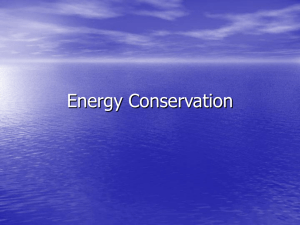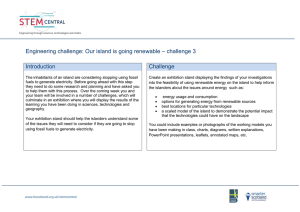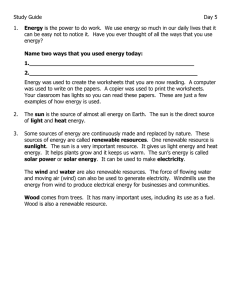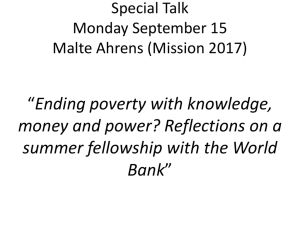From Fossil Fuels to Wind Learning Journey Introduction 1
advertisement
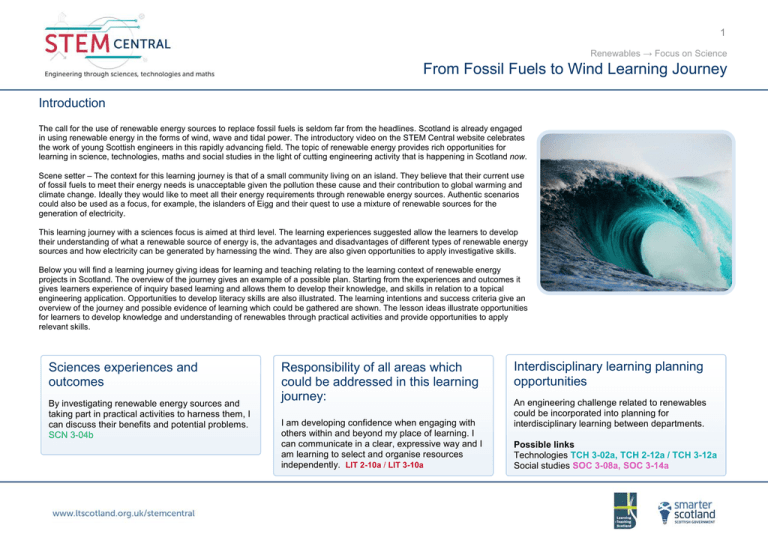
1 Renewables → Focus on Science From Fossil Fuels to Wind Learning Journey Introduction The call for the use of renewable energy sources to replace fossil fuels is seldom far from the headlines. Scotland is already engaged in usingvrenewable energy in the forms of wind, wave and tidal power. The introductory video on the STEM Central website celebrates the work of young Scottish engineers in this rapidly advancing field. The topic of renewable energy provides rich opportunities for learning in science, technologies, maths and social studies in the light of cutting engineering activity that is happening in Scotland now. Scene setter – The context for this learning journey is that of a small community living on an island. They believe that their current use of fossil fuels to meet their energy needs is unacceptable given the pollution these cause and their contribution to global warming and climate change. Ideally they would like to meet all their energy requirements through renewable energy sources. Authentic scenarios could also be used as a focus, for example, the islanders of Eigg and their quest to use a mixture of renewable sources for the generation of electricity. This learning journey with a sciences focus is aimed at third level. The learning experiences suggested allow the learners to develop their understanding of what a renewable source of energy is, the advantages and disadvantages of different types of renewable energy sources and how electricity can be generated by harnessing the wind. They are also given opportunities to apply investigative skills. Below you will find a learning journey giving ideas for learning and teaching relating to the learning context of renewable energy projects in Scotland. The overview of the journey gives an example of a possible plan. Starting from the experiences and outcomes it gives learners experience of inquiry based learning and allows them to develop their knowledge, and skills in relation to a topical engineering application. Opportunities to develop literacy skills are also illustrated. The learning intentions and success criteria give an overview of the journey and possible evidence of learning which could be gathered are shown. The lesson ideas illustrate opportunities for learners to develop knowledge and understanding of renewables through practical activities and provide opportunities to apply relevant skills. Sciences experiences and outcomes By investigating renewable energy sources and taking part in practical activities to harness them, I can discuss their benefits and potential problems. SCN 3-04b Responsibility of all areas which could be addressed in this learning journey: I am developing confidence when engaging with others within and beyond my place of learning. I can communicate in a clear, expressive way and I am learning to select and organise resources independently. LIT 2-10a / LIT 3-10a Interdisciplinary learning planning opportunities An engineering challenge related to renewables could be incorporated into planning for interdisciplinary learning between departments. Possible links Technologies TCH 3-02a, TCH 2-12a / TCH 3-12a Social studies SOC 3-08a, SOC 3-14a 2 Renewables → Focus on Science From Fossil Fuels to Wind Learning Journey Experiences and outcomes By investigating renewable energy sources and taking part in practical activities to harness them, I can discuss their benefits and potential problems. SCN 3-04b Learning intentions Success criteria Possible evidence Understand what a renewable energy source is I can give examples of renewable energy sources and explain why they are renewable Learner discussions on different energy sources Understand and analyse the advantages and disadvantages of using different sources of renewable energy I can explain the benefits and potential problems of a renewable energy source Products such as a leaflet, poster or talk I can compare and contrast the benefits and potential problems of a range of renewable energy sources Prior knowledge Through exploring non-renewable energy sources, I can describe how they are used in Scotland today and express an informed view on the implications for their future use. SCN 2-04b Understand how renewable energy sources can be used in the generation of electricity I can explain how different renewable energy sources are harnessed to generate electricity Recordings of learners comparing some of the benefits and potential problems Explanations of how electricity is generated by using technologies which harness renewable energy Discussions comparing and contrasting different processes Create and adapt a turbine to be powered by wind Investigate the effect of changing the features of the turbine on the energy output I can assemble a turbine powered by wind I can plan fair tests to find out the effect of changing different variables on the power output of the generator I can record my findings and share conclusions with others Working generator powered by ‘wind’ Written report including results with data gathered 3 Renewables → Focus on Science From Fossil Fuels to Wind Learning Journey Learning experiences: Engage – Is using fossil fuels a good thing? Introduction Learners are challenged to investigate the uses and effects of fossil fuels on the climate of the planet and to consider the implications of the continued mass use of fossil fuels. Possible tasks/challenges Possible evidence Learners prior knowledge of fossil fuels could be elicited with a carousel task where groups go around tables and record thoughts in the form of words and pictures on the key questions below: The statements prepared by groups which may range from simple posters to multimedia presentations o What are fossil fuels? o Where do they come from? o What do we use them for? Prior learning about fossil fuels should be elicited. Stimulus Tackling climate change and changing the way we live video clips at the World Wide Fund for Nature (WWF) website are useful starters: Working in small groups, the learners can be asked to discuss the following statement: We must reduce the use of fossil fuels’. Relate this to a scenario of islanders who want to reduce their use of fossil fuels. o Tackling climate change video o Changing the way we live video The groups will be provided with the opportunity to present their opinions to the class and discuss the opinions of other groups. Articles and images from a range of sources predicting the effects of the use of fossil fuels on the climate Groups could then decide on key questions that they would like to research to further inform their thinking on the effects of using fossil fuels on the climate of the planet. The groups can present their findings to the rest of the class and provide feedback to each other on their presentations. Reflecting on learning This context provides rich opportunities for planning for interdisciplinary learning. The scenario of the islanders could be used as a learning context for interdisciplinary working. Learners could reflect on which knowledge and skills they are using in different curriculum areas. Taking it further It is important that learners gain an understanding of why fossil fuels are used and the difficulties the planet faces in reducing reliance upon them. Learners could consider their previous knowledge of how electricity is generated and questions such as: o What would our lives be like if fossil fuels ran out now?” o Can we continue to live our way of life and reduce the use of fossil fuels? o Are there technologies that are being explored to reduce the harmful effects of burning fossil fuels? o What do you now think of the islanders aim to stop fossil fuels? 4 Renewables → Focus on Science From Fossil Fuels to Wind Learning Journey Learning experiences: Engage/explore activities Introduction In the engage stage learners will come to a shared understanding of what renewable and nonrenewable sources of energy are. Learners will then work in groups to explore different forms of renewable energy and their possible benefits and problems. Learning intentions o Understand what a renewable energy source is. o Understand and analyse the advantages and disadvantages of using different sources of renewable energy. Possible tasks/challenges Possible evidence Learners may have good prior knowledge of what renewable energy is but an engage activity could be used to help orientate learners in the topic and help the class to come to a common understanding/definition. o Learners’ discussions of different energy sources o Groups create a product such as a leaflet, poster or talk to share their findings with the rest of the class Learners could be given pictures of different energy sources (both renewable and non-renewable) and asked to work in groups to list examples of how that energy source can be harnessed. They could be challenged to come up with as many ideas as possible for certain energy sources, for example, wind. Each group could then be asked to categorise the sources into renewable and non-renewable and discuss v a definition for these terms before the class comes to a shared definition through discussion. Taking it further The class could now work in groups to research a particular way of harnessing a renewable source. This could be related to the scenario of the islanders who want to use more renewables and would like more information to help them decide which sources they might explore further. Groups could discuss what kind of information the islanders might like to have to help them make informed choices. Ideas they might come up with could include: What are the main plus points of this form of renewable technology? What are some of the possible disadvantages? Are there possible environmental impacts? What is the carbon cost of that technology and how long would it take to pay back? The strategy ‘expert jigsaw’ could be used to help the learners find out more about different ways of harnessing renewable energy. ‘Expert jigsaw’ is where learners work in a temporary expert group, create a product to explain to others what they have found out and then return to a group where everyone has researched a different form of renewable and then each member of the group teaches the others about their area of expertise. A detailed description of this strategy can be found at the link below. o An explanation of the jigsaw strategy Groups could then decide on some way of creating a comparison of the different forms of renewable energy, to help inform the islanders. 5 Renewables → Focus on Science From Fossil Fuels to Wind Learning Journey Learning experiences: Engage/explore activities Introduction Learners will explore what we use energy for and how power stations generate electricity. They will then carry out practical investigations to help them come to a better understanding of how electricity is generated. Stimulus o Collage of domestic devices that use mains electricity o Video clips advertising domestic devises that use mains electricity Learning intention Understand how renewable energy sources can be used in the generation of electricity. Possible tasks/challenge Resources Elicit learners previous knowledge about how electricity is generated inside a power station. Groups could be given some pictures of the different parts of the process of generating electricity inside a coal or gas power station and asked to order them and explain the process. A range of small dc electric motors LEDs and small low voltage filament lamps Simple components and construction materials to make rotary drive systems Simple materials and tools to construct electric circuits Multimeters to measure performance of circuits Information or suggested web links on a range of renewable technologies They could then research what actually happens and compare this to their original thinking. Demonstrate to the class how a small electric motor may be used as a generator to light an LED or small filament lamp. In a further session learners could make simple generators and explore how to make the generator coil spin as fast as possible, for example, by changing the number of coils, using a different strength of magnet. A STEM ambassador could be invited in to assist with this. The video below is a useful resource for this activity. o YouTube video explaining how to make a simple generator Possible evidence Learners’ explanations of how electricity is generated by harnessing renewable technologies and their discussions comparing and contrasting different processes. Taking it further Learners could now choose a form of renewable energy technology such as the Oyster, Scottish power’s tidal scheme, wind or solar and research how the technology is used to generate electricity. Learners could be asked to explain the similarities and differences between the generation of electricity from the renewable source of energy they researched and generation in a traditional coal or gas power station. 6 Renewables → Focus on Science From Fossil Fuels to Wind Learning Journey Learning experiences: Evaluate Introduction An interdisciplinary project would allow learners to apply their learning to a new and more challenging context for learning where the knowledge and skills from different curriculum areas could be applied to the solving of problems that involve engineering in education skills. As an introduction to an interdisciplinary off timetable challenge week the learners could now meet their group and do some activities to help form a team identity. The groups now have the opportunity to think about their learning so far and present this to one another and teachers. Stimulus A large poster or projection with the words ‘So what?’ plus images of coal fired power stations Learning intention Evaluate how skills and knowledge from different curriculum areas are used together to solve problems and understand how this mirrors the world of work. Possible tasks/challenge Working in small groups, learners should develop a statement in three parts. Part 1 starts ‘This is what we have learned …’ Part 2 starts ‘This is how we learned …’ Part 3 starts ‘This is why we think this learning is important …’ They could then reflect on the skills and knowledge they have been working on in sciences, social studies and technologies and consider how they might be useful in the interdisciplinary challenges they will be working on during their interdisciplinary project, The Island. Towards the end of the lesson, each group presents their statements and thinking, in a range of ways. Groups will then reflect on the challenges ahead. This would give them ‘cooking time’ (time for ideas to settle before the planning stage) for planning, idea generation and other skills. Reflecting on learning Learners should reflect upon how experts such as engineers, geologists, geographers and scientists collaborate to solve problems and engineer solutions. Why are the knowledge and skills of one discipline not enough to help the islanders analyse and create solutions to their problems? Someone working in the renewables sector could introduce the challenge week to help learners gain insights into the world of work. Responsibility of all This project would give strong opportunities to address an aspect of responsibility of all such as: I am developing confidence when engaging with others within and beyond my place of learning. I can communicate in a clear, expressive way and I am learning to select and organise resources independently. LIT 2-10a / LIT 3-10a Possible evidence o The statements prepared by learners which may range from simple posters to multi media presentations o The video below might be a good stimulus to discussion for groups considering some of the issues for moving to using renewable sources
